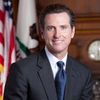Today, the most famous building in San Francisco is also one of the most environmentally friendly in the country. The Transamerica Pyramid building has achieved a LEED Gold certification.
Even in these difficult economic times, green building is taking off in San Francisco, thanks to our aggressive green building regulations for new construction and large-scale retrofits, the strongest in the nation. In 2009, LEED certified square footage has increased five-fold in San Francisco. We now have more green buildings than New York or Los Angeles.
However, new construction and major renovation projects represent less than 1 percent of the city's real estate each year. At the standard rate of 0.8 percent new buildings per year in San Francisco, it could take more than sixty years to green even half of the City. When you add to the fact that buildings make up 45 percent of our city's greenhouse gas emissions, it is clear we need to address San Francisco's existing buildings.
That's why in February of this year, I convened the Existing Commercial Buildings Task Force, bringing together 19 key stakeholders from San Francisco's building community to recommend practical solutions to green the city's existing commercial buildings. They delivered their final report and recommendations (PDF) to me today.
Amplifying the great work already happening in San Francisco with our energy, water efficiency, and zero waste initiatives, the Task Force recommends that commercial buildings adopt a voluntary goal: cut total energy use in existing commercial buildings 50 percent by 2030.
The Task Force also recommends that the City require commercial buildings to conduct a performance audit to identify cost-effective ways to reduce energy use. Our experience with existing rate-payer efficiency programs shows that at least 40 percent of businesses that conduct an audit will undertake efficiency measures.
When business owners see how much they can improve their bottom line with energy efficiency--and the incentives and rebates available to minimize upfront costs--the decision is a simple one.
Another recommendation is to require each business to benchmark energy use annually and make that information public. Information in this case is quite literally power. This metric empowers potential building tenants or buyers to favor energy efficient buildings, just like a potential car buyer may consider miles per gallon when making their purchase. By making energy use public, it will further incentivize building owners to maximize environmental performance.
If fully implemented, the proposed Task Force strategy is expected to generate hundreds of new green jobs in commercial energy efficiency, and lead to annual greenhouse gas reductions of 70,000 tons within five years--while saving the private sector more than $600 million.
